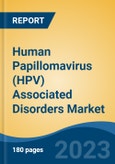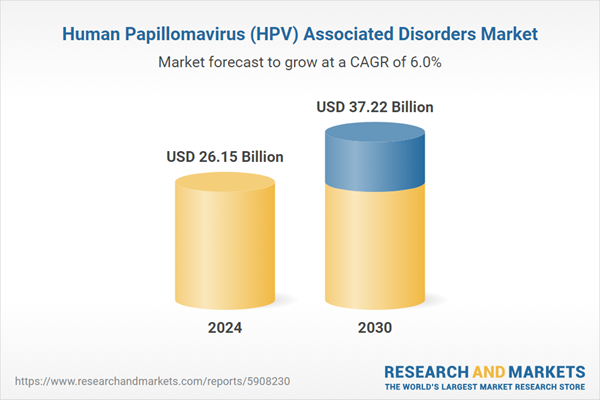Free Webex Call
The Human Papillomavirus (HPV) Associated Disorders Market was valued at USD 26.15 Billion in 2024, and is expected to reach USD 37.22 Billion by 2030, rising at a CAGR of 6.02%. Human Papillomavirus (HPV) is one of the most common sexually transmitted infections globally. While many HPV infections are benign and resolve on their own, some strains of the virus are associated with a range of disorders, including cervical cancer, genital warts, and various other cancers affecting both men and women. The global HPV-associated disorders market has been witnessing significant growth in recent years, driven by advancements in healthcare technologies, increased awareness, and proactive measures for prevention and treatment. Speak directly to the analyst to clarify any post sales queries you may have.
10% Free customizationThis report comes with 10% free customization, enabling you to add data that meets your specific business needs.
The global HPV-associated disorders market is influenced by several factors. The introduction of HPV vaccines has been a game-changer in the fight against HPV-associated disorders. These vaccines, such as Gardasil and Cervarix, offer protection against the most dangerous HPV strains. Governments and healthcare organizations around the world have been actively promoting vaccination programs to reduce the prevalence of these disorders. Routine screenings, including Pap smears and HPV DNA tests, have become integral in early detection and prevention efforts. This has led to increased demand for diagnostic tools and services in the market.
Key Market Drivers
Rising HPV Prevalence and Growing Disease Burden
The increasing prevalence of human papillomavirus (HPV) infections and the associated disease burden are major factors fueling the growth of the global HPV-associated disorders market. Human papillomavirus (HPV) is a significant global health concern, responsible for an estimated 620,000 cancer cases in women and 70,000 in men annually. Preventive HPV vaccination has proven highly effective in reducing the risk of these cancers, offering a proactive approach to disease prevention. Additionally, HPV screening and the timely treatment of precancerous lesions serve as critical interventions in cervical cancer prevention, enhancing early detection and reducing healthcare burdens.These strategies are driving demand for advanced screening technologies, expanded vaccination programs, and innovative therapeutic solutions in the global healthcare market. As HPV continues to be one of the most common sexually transmitted infections (STIs) worldwide, the rising incidence of HPV-related diseases - such as cervical cancer, oropharyngeal cancer, anal cancer, and genital warts - has created a significant demand for preventive and therapeutic solutions.
HPV is one of the most widespread viral infections globally, with millions of new cases reported each year. According to the World Health Organization (WHO), nearly 80% of sexually active individuals will contract HPV at some point in their lives. The virus is highly transmissible through skin-to-skin contact and sexual activity, contributing to its rapid spread across diverse populations. The persistent rise in infection rates has heightened the demand for routine screening, early diagnosis, and advanced treatment options, driving growth in the HPV-associated disorders market.
Key Market Challenges
Limited Awareness and Education
One of the primary challenges in the HPV Associated Disorders Market is the lack of awareness and education among the general public and healthcare professionals. Many people, particularly in low- and middle-income countries, are unaware of the risks associated with HPV and the importance of vaccination and regular screening. This limited awareness can result in missed opportunities for early detection and prevention. To address this challenge, there is a need for comprehensive public health campaigns and educational initiatives that emphasize the importance of HPV vaccination, regular screenings, and safe sexual practices. Collaborative efforts between governments, healthcare organizations, and pharmaceutical companies can help raise awareness and improve education about HPV-associated disorders.Key Market Trends
Technological Advancements
Technological advancements have long been a driving force in the healthcare industry, enabling better diagnosis, treatment, and prevention of various diseases. One such area where technology is making a significant impact is the management of Human Papillomavirus (HPV) associated disorders. HPV is a widespread virus that can lead to various health issues, including cervical cancer, genital warts, and oropharyngeal cancer. In recent years, the global HPV associated disorders market has witnessed remarkable growth, largely attributed to expanding technological advancements.One of the key ways technological advancements are influencing the HPV associated disorders market is through the development of more accurate and accessible screening techniques. Traditionally, Pap smears and HPV DNA tests were the primary methods for detecting HPV and its associated risks. However, newer technologies such as liquid-based cytology and molecular testing have emerged. Liquid-based cytology involves collecting a cervical cell sample and placing it in a liquid medium, making it easier to identify abnormalities. Molecular testing, on the other hand, detects the genetic material of the virus, providing more precise results. These advanced screening methods not only improve the accuracy of HPV diagnosis but also offer quicker results, reducing patient anxiety and expediting the start of treatment when necessary.
Key Market Players
- Alembic Pharmaceuticals
- AstraZeneca plc
- Bausch Health Companies Inc
- Biocon Ltd.
- Bristol-Myers Squibb Co.
- Eli Lilly and Company.
- F. Hoffmann-La Roche Ltd
- GlaxoSmithKline plc
- Merck & Co., Inc.
- Novartis AG
- Pfizer, Inc.
Report Scope:
In this report, the Global Human Papillomavirus (HPV) Associated Disorders Market has been segmented into the following categories, in addition to the industry trends which have also been detailed below:Human Papillomavirus (HPV) Associated Disorders Market, By Indication:
- AIN
- Anal Cancer
- Cervical Cancer
- CIN
- Genital Warts
Human Papillomavirus (HPV) Associated Disorders Market, By Therapy:
- Prevention
- Treatment
Human Papillomavirus (HPV) Associated Disorders Market, By End user:
- Hospitals & Clinics
- Ambulatory Care Centers
- Others
Human Papillomavirus (HPV) Associated Disorders Market, By Region:
- North America
- United States
- Canada
- Mexico
- Europe
- France
- United Kingdom
- Italy
- Germany
- Spain
- Asia-Pacific
- China
- India
- Japan
- Australia
- South Korea
- South America
- Brazil
- Argentina
- Colombia
- Middle East & Africa
- South Africa
- Saudi Arabia
- UAE
Competitive Landscape
Company Profiles: Detailed analysis of the major companies present in the Human Papillomavirus (HPV) Associated Disorders Market.Available Customizations:
With the given market data, the publisher offers customizations according to a company's specific needs. The following customization options are available for the report.Company Information
- Detailed analysis and profiling of additional market players (up to five).
This product will be delivered within 1-3 business days.
Table of Contents
1. Product Overview
2. Research Methodology
3. Executive Summary
5. Global Human Papillomavirus (HPV) Associated Disorders Market Outlook
6. North America Human Papillomavirus (HPV) Associated Disorders Market Outlook
7. Europe Human Papillomavirus (HPV) Associated Disorders Market Outlook
8. Asia-Pacific Human Papillomavirus (HPV) Associated Disorders Market Outlook
9. South America Human Papillomavirus (HPV) Associated Disorders Market Outlook
10. Middle East and Africa Human Papillomavirus (HPV) Associated Disorders Market Outlook
11. Market Dynamics
12. Market Trends & Developments
14. Competitive Landscape
Companies Mentioned
- Alembic Pharmaceuticals
- AstraZeneca plc
- Bausch Health Companies Inc
- Biocon Ltd.
- Bristol-Myers Squibb Co.
- Eli Lilly and Company.
- F. Hoffmann-La Roche Ltd
- GlaxoSmithKline plc
- Merck & Co., Inc.
- Novartis AG
- Pfizer, Inc.
Table Information
| Report Attribute | Details |
|---|---|
| No. of Pages | 185 |
| Published | March 2025 |
| Forecast Period | 2024 - 2030 |
| Estimated Market Value ( USD | $ 26.15 Billion |
| Forecasted Market Value ( USD | $ 37.22 Billion |
| Compound Annual Growth Rate | 6.0% |
| Regions Covered | Global |
| No. of Companies Mentioned | 11 |









